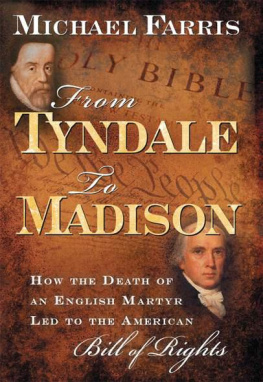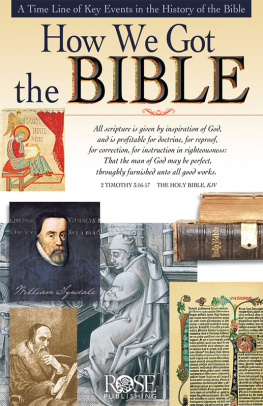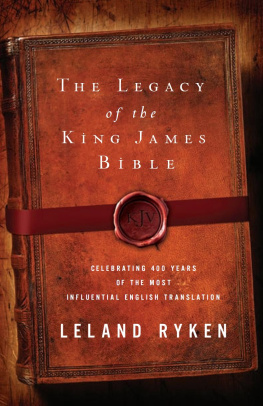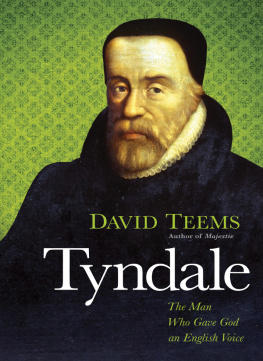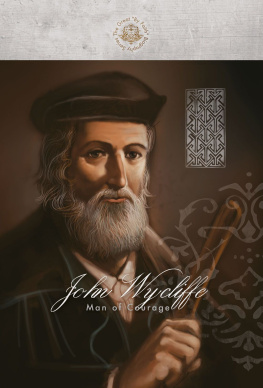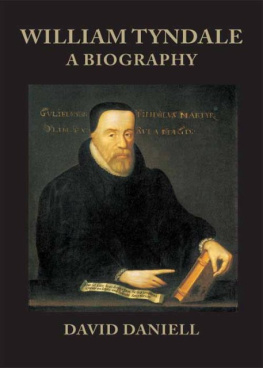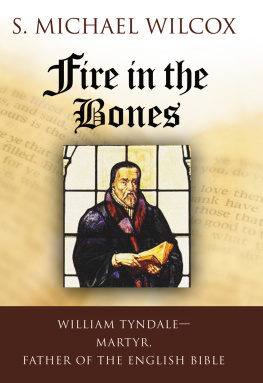
ENDORSEMENTS
The most basic freedom of all is freedom of religion. Michael P. Farris, in his volume From Tyndale to Madison, has given to every lover of liberty one of the most thoughtful and helpful volumes in recent generations. My own conviction is that there will be no volume published this year that demands as careful a reading as this book. Especially do I wish that every member of the congress and the judiciary, together with every pastor in America, would read this volume and apply it to their life and work.
Paige Patterson, President
Southwestern Baptist Theological Seminary
Fort Worth, Texas
A tour de force of extraordinary magnitude and unusual importance. Only rarely does a book posses the significance of From Tyndale to Madison. Drawing upon a remarkable array of primary and secondary sources, Michael P. Farris meticulously and successfully debunks the myths that the Enlightenment is responsible for the American Bill of Rights and that Enlightenment philosophies were chiefly responsible for opening people's minds to the error of religious persecution and paving the way for a society in which heretics are not tortured and burnt in town squares. From Tyndale to Madison is a must read for everyone interested in history.
Charles W. Dunn, Dean
Regent University
Virginia Beach, Virginia
This fascinating account of where the American dream of liberty of conscience that produced the religious freedom we all so freely enjoy in this country today, originated in the heart of William Tyndale. He was helped of course by other heroic men of faith who also have their lives to translate and distribute the Word of God into English so that every man, even the ploughman could read the Bible for himself. Tyndale was right. Bible reading in one's own language did transform religion in Europe and became the driving force that produced religious freedom in the American colonies.
This book proves beyond doubt that the enlightenment had little or no influence on our treasured religious freedom. Instead it was fostered by men like John Witherspoon, the president of Princeton College, a Scottish Presbyterian preacher and legal scholar who by his teaching educated many of the founders who went as delegates to the Continental Congress, particularly James Madison, who was considered the father of the Constitution.
In this exciting history, Mike Farris traces the story of how familiarity with the Bible and the faith it inspires is what really produced the religious freedom that is the bedrock foundation of our country. Once I began reading it, I could not lay it down. I heartily recommend this book to anyone who would want to know the truth about the history of America!
Tim LaHaye
Tim LaHaye Ministries



Dedication
To J. Michael Smith, my
co-laborer in the battle for
religious and parental liberty.
ACKNOWLEDGMENTS
Naomi Harralson, my invaluable researcher and associate, has lived up to the accolades bestowed upon her at Patrick Henry College. She was awarded the 2005 Beverly LaHaye Leadership Award as the outstanding female graduate. Without her this book would not have been possible. My two assistants, Amanda Taylor and Rachel Kozlowski, help keep my life organized so that projects of this magnitude are even possible. John Vinci helped in the early stages of research and discovered the critical collection of Early English Books Online.
Helen Marie Taylor, a relative of James Madison and a Virginia patriot, first alerted me to the possible family relationship between William Tyndale and James Madison. This opened up an entire new venue for research that paid numerous dividends in finding out the full story of the history of religious freedom.
CONTENTS
INTRODUCTION
M y own college textbook from a political philosophy class espoused a common view regarding the source of contemporary religious liberty. Enlightenment philosophies, it taught, were chiefly responsible for opening people's minds to the error of religious persecution and paving the way for a society in which heretics are not tortured and burnt in town squares.
This conception has not gone away. I recently served as a judge for a national essay contest in which the contestant instructions explained that religious liberty is a concept derived from the European Enlightenment. After all, the general argument goes, devoted Christians have often been the chief persecutors in Western history and therefore cannot be said to have had a positive role in advancing the idea that the civil magistrate should not interfere with matters of conscience. On the contrary, it is said, the forces most inimical to genuine Christian faitha general religious apathy among the populace, relativism in regard to truth, a growing secularist mind-set, and Enlightenment-influenced skepticism among intellectual leaderswere the primary forces behind the triumph of religious liberty in the West.
Examples come from diverse sources. Firuz Kazemzadeh, an esteemed Ivy League scholar who has been appointed and reappointed to the U.S. Commission on International Religious Freedom, attributes the failure of Muslim nations to embrace religious liberty to the fact that they have neither gone through the Enlightenment nor developed any of the attitudes that formed the minds of the founding fathers of this country, including deism and a measure of skepticism in matters of religion which permitted the kind of tolerance which we all seek today.
We have to recognize the truth of the claim that professing Christians were indeed the principal persecutors during the relevant era in which religious liberty emerged. But is it necessarily true that the heroes who stood against persecution and brought liberty of conscience to the forefront in America were avowed skeptics and unorthodox secularists? The goal of this book is to answer this question by undertaking a detailed account of the troubling history of religious persecution from the sixteenth through the eighteenth centuries, chiefly in England, and by exploring the ideas that brought religious liberty to America.
Today all Christian denominations embrace religious liberty as an ideal. But it was not always so. It is improper to judge today's adherents of a particular branch of Christianity by the acts of their distant theological cousins. Moreover, it is unfair to denigrate entirely the life's work of significant religious reformers for their failure to embrace religious liberty.
Yet the sad truth is that some giants of the faith were religious persecutors. The story that follows is told with unflinching honesty. However, it must be borne in mind that this book is limited to a discussion of religious liberty. The scope affords no opportunity to praise these individuals' many other positive achievements. It is similar to a discussion of the founding fathers and slavery: even those who owned slaves and defended slavery, as regrettable as this was, made significant contributions to the founding of this nation. Indeed, the foundations they laid were chiefly responsible for slavery's eventual eradication.
In a similar way, religious liberty arose gradually. Catholics, Anglicans, Calvinists, and Lutherans persecuted each other and other smaller groups of dissenters. It would be erroneous to castigate men or entire movements for their failures without recognizing their achievements in other areas. At the end of the road, an Anglican, James Madison, trained in liberty by a Calvinist Presbyterian, John Witherspoon, worked with the persecuted Baptists of Virginia to turn a broken theory of religious toleration into the robust experience of religious liberty that has changed America and the world.
Next page
